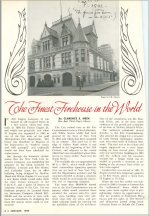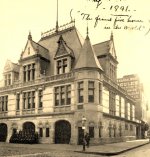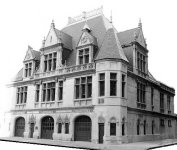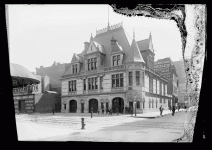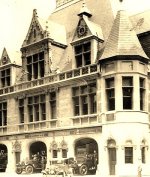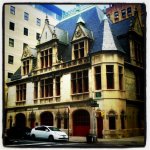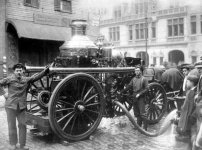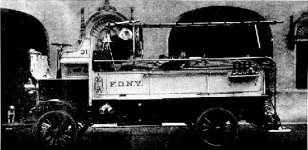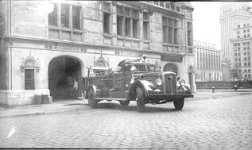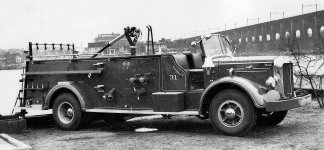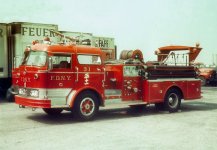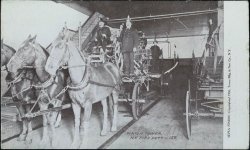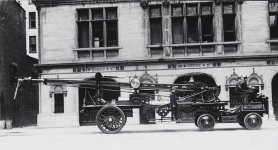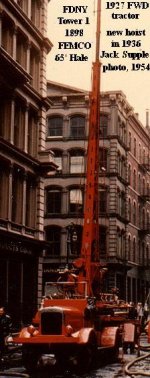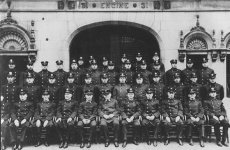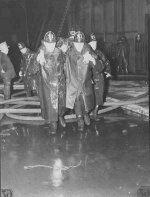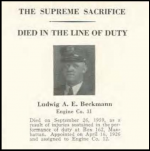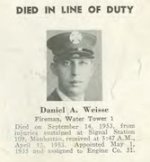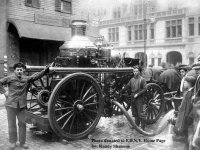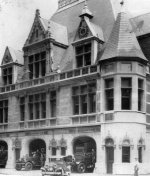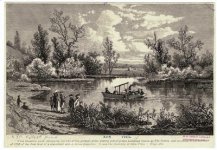You are using an out of date browser. It may not display this or other websites correctly.
You should upgrade or use an alternative browser.
You should upgrade or use an alternative browser.
FDNY and NYC Firehouses and Fire Companies - 2nd Section
- Thread starter mack
- Start date
- Joined
- Jan 20, 2014
- Messages
- 19,148
Maybe some one could help answer this
Once a member of this site Jose Ciscone asked this question on a Facebook post in a group in regards to E13’s quarters now the museum
“Also house of Battalion 2 and Water Tower 1….. does anyone know what this bay was used for on the White Street side of the building”
Once a member of this site Jose Ciscone asked this question on a Facebook post in a group in regards to E13’s quarters now the museum
“Also house of Battalion 2 and Water Tower 1….. does anyone know what this bay was used for on the White Street side of the building”

- Joined
- Nov 2, 2020
- Messages
- 1,294
Are you referring to E31's old quarters on Lafayette Street? If so, I think, although not certain, back in the day it was used for a horse stable. Could be wrong.
FDNY units located at 87 Lafayette Street firehouse:
ENGINE 31 MANHATTAN
ORG. 116 Leonard St. FQ Vol. (Oct. 20, 1865)
RELOC. 68 Elm St. (Temp.) (Apr. 1, 1894)
NQTRS. Elm St. & White St. W/ Tow. 1 (Jun. 3, 1896)
CHANGE 87 Lafayette St. (Dec. 15, 1905)
RELOC. 363 Broome St. At E-55 (Feb. 1965)
RQTRS. 87 Lafayette St. (Apr. 1965)
RELOC. 100 Duane St. At E-7 (Feb. 2, 1967)
RELOC. 363 Broome St. At E-55 (Feb. 26, 1970)
DISB. (Nov. 25, 1972)
ENGINE 31 (2) MANHATTAN
ORG. 116 Leonard St. At E-31 (May 1, 1883)
RELOC. 68 Elm St. W/ E-31 (Apr. 1, 1894)
NQTRS. Elm St. & White St. W/ E-31 (Jun. 3, 1896)
CHANGE 87 Lafayette St. (Dec. 15, 1905)
DISB. (May 1, 1918)
REORG. 87 Lafayette St. At E-31 (Dec. 3, 1925)
DISB. (Jul. 1, 1939)
WATER TOWER 1 MANHATTAN
ORG. 22 Chambers St. At E-7 (Jul. 2, 1879)
NQTRS. Elm St. & White St. W/ E-31 (Jun. 3, 1896)
CHANGE 87 Lafayette St. (Dec. 15, 1905) DISB. (Apr. 1, 1957)
BATTALION 2 MANHATTAN
ORG. 26 Chambers St. At L-1 (Jan. 1, 1869)
RELOC. 68 Elm St. W/ E-31 (Apr. 1, 1894)
NQTRS. Elm St. & White St. W/ E-31 (Jun. 1, 1896)
CHANGE 87 Lafayette St. (Dec. 15, 1905)
DISB. (Aug. 1, 1948)
REORG. 87 Lafayette St. At E-31 (Jan. 3, 1951)
RELOC. 100 Duane St. At E-7 (Feb. 1965)
RELOC. 87 Lafayette St. W/ E-31 (Apr. 1965)
RELOC. 100 Duane St. At E-7 (Feb. 2, 1967)
RELOC. 251 Lafayette St. At L-20 (Dec. 16, 1974)
RELOC. 363 Broome St. At E-55 (Nov. 12, 1975)
RELOC. 227 6th Ave. At E-24 (Aug. 25, 1998)
DIVISION 1 MANHATTAN
Located at 87 Lafayette Street 1956
SATELLITE 1 MANHATTAN
Located at 87 Lafayette Street at Engine 31 1965-1967
RELAY HOSE WAGON MANHATTAN
Located at 87 Lafayette Street at Engine 31 1965
ENGINE 31 MANHATTAN
ORG. 116 Leonard St. FQ Vol. (Oct. 20, 1865)
RELOC. 68 Elm St. (Temp.) (Apr. 1, 1894)
NQTRS. Elm St. & White St. W/ Tow. 1 (Jun. 3, 1896)
CHANGE 87 Lafayette St. (Dec. 15, 1905)
RELOC. 363 Broome St. At E-55 (Feb. 1965)
RQTRS. 87 Lafayette St. (Apr. 1965)
RELOC. 100 Duane St. At E-7 (Feb. 2, 1967)
RELOC. 363 Broome St. At E-55 (Feb. 26, 1970)
DISB. (Nov. 25, 1972)
ENGINE 31 (2) MANHATTAN
ORG. 116 Leonard St. At E-31 (May 1, 1883)
RELOC. 68 Elm St. W/ E-31 (Apr. 1, 1894)
NQTRS. Elm St. & White St. W/ E-31 (Jun. 3, 1896)
CHANGE 87 Lafayette St. (Dec. 15, 1905)
DISB. (May 1, 1918)
REORG. 87 Lafayette St. At E-31 (Dec. 3, 1925)
DISB. (Jul. 1, 1939)
WATER TOWER 1 MANHATTAN
ORG. 22 Chambers St. At E-7 (Jul. 2, 1879)
NQTRS. Elm St. & White St. W/ E-31 (Jun. 3, 1896)
CHANGE 87 Lafayette St. (Dec. 15, 1905) DISB. (Apr. 1, 1957)
BATTALION 2 MANHATTAN
ORG. 26 Chambers St. At L-1 (Jan. 1, 1869)
RELOC. 68 Elm St. W/ E-31 (Apr. 1, 1894)
NQTRS. Elm St. & White St. W/ E-31 (Jun. 1, 1896)
CHANGE 87 Lafayette St. (Dec. 15, 1905)
DISB. (Aug. 1, 1948)
REORG. 87 Lafayette St. At E-31 (Jan. 3, 1951)
RELOC. 100 Duane St. At E-7 (Feb. 1965)
RELOC. 87 Lafayette St. W/ E-31 (Apr. 1965)
RELOC. 100 Duane St. At E-7 (Feb. 2, 1967)
RELOC. 251 Lafayette St. At L-20 (Dec. 16, 1974)
RELOC. 363 Broome St. At E-55 (Nov. 12, 1975)
RELOC. 227 6th Ave. At E-24 (Aug. 25, 1998)
DIVISION 1 MANHATTAN
Located at 87 Lafayette Street 1956
SATELLITE 1 MANHATTAN
Located at 87 Lafayette Street at Engine 31 1965-1967
RELAY HOSE WAGON MANHATTAN
Located at 87 Lafayette Street at Engine 31 1965
Last edited:
Engine 31 LODDs
Water Tower 1 LODDs
Battalion 2 LODD
RIP. Never forget.
| FIREFIGHTER | MORRIS GRAF | ENGINE 31 | January 22, 1945 |
| FIREFIGHTER | LUDWIG A. BECKMAN | ENGINE 31 | September 26, 1959 |
| LIEUTENANT | JOHN J. McDERMOTT | ENGINE 31 | November 18, 1960 |
| FIREFIGHTER | FRANCIS J. SAMMON | ENGINE 31 | November 18, 1960 |
Water Tower 1 LODDs
| FIREFIGHTER | JAMES A. ROGERS | WATER TOWER 1 | September 2, 1963 |
| FIREFIGHTER | DANIEL A. WEISSE | WATER TOWER 1 | September 14, 1953 |
Battalion 2 LODD
| BATTALION CHIEF | WILLIAM J. WALSH | BATTALION 2 | January 9, 1912 |
RIP. Never forget.
Members of the New York City Fire Department with Engine 31, died in the line of duty 18 Nov 1960. While fighting a fire at 463 Broadway, at Grand St., in Manhattan, fireman Francis J. Sammon was trapped in the cellar with 2 other firemen, Lt. John C. McDermott and fireman John C. Cosner. The three firemen could not be rescued and died in the fire.
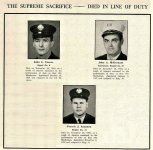
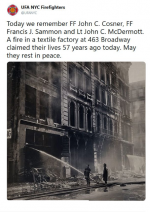


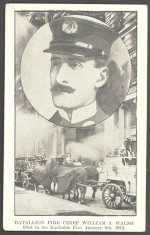
January 9, 1912 - LODD
Battalion Chief William J. Walsh, 43 - Battalion 2
FDNY. Manhattan, New York
A spectacular fire destroyed an eight-story, block-square, life assurance building. As a result of employees who tried to fight the fire themselves, the alarm was delayed and allowed for heavy fire involvement of the first four floors before the arrival of firefighters. During the fire, two insurance officials, who were trapped in the basement vault section behind two-inch steel bars, were rescued after over an hour of arduous work by firefighters using hacksaws. Rescuers had to contend with falling debris and total building failure to rescue the trapped men. Walsh was killed at this fire, in addition to six civilians, two of whom jumped to their deaths from the roof. Walsh was killed when he was caught in a collapse on the fourth floor while trying to make an interior attack on the fire. He was buried under tons of debris and it was several days before his crushed body was found at the third floor level.
Fireman James A. Rogers of Water Tower 1 was retired for nineteen years before he died from the injuries he received in the line of duty. Appointed on January 20, 1920, he was assigned to Engine 31 where he spent most of his career. In 1926 he spent three months at Engine 91. When Water Tower 1 separated from Engine 31 and became a separate company, Fireman Rogers was transferred to it. The Board of Trustees of the Fire Department Pension Fund determined his death to be in the line of duty on June 10, 1964. He was seventy years old when he died. (From "The Last Alarm, by Boucher, Urbanowicz & Melahn, 2007)
Engine Company 31 was organized on October 20,1865. It served proudly in the above firehouse. It was disbanded on November 25, 1972.
Engineer James P. Shannon tending Engine 31s steamer in the front of quarters.
I think it was in the summer of 1972 that I first heard of the firehouse in lower Manhattan. I read in the newspaper that the city was going to sell a firehouse at public auction. Not thinking much of it at the time I just happened to be on Canal Street one day and came across that firehouse with a notice of sale posted on it. I could not believe my eyes; it was gorgeous almost like a gingerbread house or a French chateau. I asked myself how could the city sell such a beautiful building? It was one of a kind. I wondered then about the history behind that building and about the men who once worked there.
Many years later after starting this page, I was about to rediscover that same building and learn more about it. I helped the Fire Museum start on the web, when I found they had no presence on the Internet. They had old computers and no modems at all. I developed a page for them and posted it for the rest of the world to see. In turn they let me sign out some old photos, take them home and scan them and put them on the respective companies' pages. I try to get there about once a month when I can. One day while in the basement of the museum I came upon an old photo of that building and this time I learned it was the former quarters of Engine company 31. It was still early so I decided to walk down to Canal Street and see if I could re-find the old firehouse. I had remembered that it was south of Canal but didn't know on what cross street it was on. I kept walking east on the southern side of Canal Street and kept looking south at every intersection. When I got to Lafayette Street there it was, two blocks south. I walked up to it but it was locked so I went across the street and took a photo of it. I then saw some people going in,and I went across the street, spoke to them, and asked if it would be ok to have a look inside.
I met with the new owners and showed them the old photo of Engine 31, which they now owned. They let me walk around and I could just feel and almost hear the sounds of the past. There was a tremendous sense of history in that building and I seemed to feel it very strongly. They were on the net so I sat down and called up the FDNY Home Page and bookmarked it for them. I thanked them and went on my way home.
About a week later another person was in search of that very same building, his name was Randy Shannon. He also had a photo of that same building, taken from almost the same exact spot from where I had just taken the photo a week earlier, but he had an image of a fireman or engineer across the street complete with a steamer and horses. He also went in and spoke to the new owners and they showed him around and told him that I had been there. They also showed him the web site that I had left behind and he e-mailed me a few days later. Randy said he had some old photos of his grandfather when he was an engineer in Engine Company 31.
We got together and he left the photos and some papers for me to scan and make a page about his grandfather. When I had finished and he came over to pick them up I told him that he should have them duplicated and to give them the Fire Museum. He did just that and while going over the papers and photos with the collections manager Peter, they discovered that his grandfather was also a Lieutenant In Engine 30 at 278 Spring Street. 278 Spring Street is the current location of the New York City Fire Museum; it was once Engine Company 30!
Don, Webmaster 2/14/99
What made me go to Engine 31? What made Randy go to Engine 31? And now his papers are in a firehouse where he worked as a Lieutenant, Engine Company 30 at 278 Spring Street.
Engineer James P. Shannon tending Engine 31s steamer in the front of quarters.
I think it was in the summer of 1972 that I first heard of the firehouse in lower Manhattan. I read in the newspaper that the city was going to sell a firehouse at public auction. Not thinking much of it at the time I just happened to be on Canal Street one day and came across that firehouse with a notice of sale posted on it. I could not believe my eyes; it was gorgeous almost like a gingerbread house or a French chateau. I asked myself how could the city sell such a beautiful building? It was one of a kind. I wondered then about the history behind that building and about the men who once worked there.
Many years later after starting this page, I was about to rediscover that same building and learn more about it. I helped the Fire Museum start on the web, when I found they had no presence on the Internet. They had old computers and no modems at all. I developed a page for them and posted it for the rest of the world to see. In turn they let me sign out some old photos, take them home and scan them and put them on the respective companies' pages. I try to get there about once a month when I can. One day while in the basement of the museum I came upon an old photo of that building and this time I learned it was the former quarters of Engine company 31. It was still early so I decided to walk down to Canal Street and see if I could re-find the old firehouse. I had remembered that it was south of Canal but didn't know on what cross street it was on. I kept walking east on the southern side of Canal Street and kept looking south at every intersection. When I got to Lafayette Street there it was, two blocks south. I walked up to it but it was locked so I went across the street and took a photo of it. I then saw some people going in,and I went across the street, spoke to them, and asked if it would be ok to have a look inside.
I met with the new owners and showed them the old photo of Engine 31, which they now owned. They let me walk around and I could just feel and almost hear the sounds of the past. There was a tremendous sense of history in that building and I seemed to feel it very strongly. They were on the net so I sat down and called up the FDNY Home Page and bookmarked it for them. I thanked them and went on my way home.
About a week later another person was in search of that very same building, his name was Randy Shannon. He also had a photo of that same building, taken from almost the same exact spot from where I had just taken the photo a week earlier, but he had an image of a fireman or engineer across the street complete with a steamer and horses. He also went in and spoke to the new owners and they showed him around and told him that I had been there. They also showed him the web site that I had left behind and he e-mailed me a few days later. Randy said he had some old photos of his grandfather when he was an engineer in Engine Company 31.
We got together and he left the photos and some papers for me to scan and make a page about his grandfather. When I had finished and he came over to pick them up I told him that he should have them duplicated and to give them the Fire Museum. He did just that and while going over the papers and photos with the collections manager Peter, they discovered that his grandfather was also a Lieutenant In Engine 30 at 278 Spring Street. 278 Spring Street is the current location of the New York City Fire Museum; it was once Engine Company 30!
Don, Webmaster 2/14/99
What made me go to Engine 31? What made Randy go to Engine 31? And now his papers are in a firehouse where he worked as a Lieutenant, Engine Company 30 at 278 Spring Street.

Wednesday, May 12, 2010
Engine Company 31 - 87 Lafayette Street
In 1879 Napoleon LeBrun became the official architect of the New York City Fire Department. When son Pierre joined him the firm became N. LeBrun & Son. LeBrun would produce 42 structures for the fire department before stepping down in 1895. But he went out with a splash.
In 1894 N. LeBrun & Son drew plans for a lavish new home for Engine Company 31, which had been situated at No. 116 Leonard Street. But first the architects had to deal with a logistical nightmare.
The site where the new firehouse was to be built was atop a filled-in body of water called Collect Pond. In the 18th century the pond covered 48 acres and, in spots, was up to 60 feet deep. What had been a popular place for picnics in the summer and ice skating in the winter became polluted and odorous when tanneries, slaughterhouses and other nearby business dumped their waste here. Derided at the end of the 18th century as "a very sink and common sewer," it was slowly filled. By 1813, the entire lake was undetectable. At least on the surface.
Below ground the water remained. LeBrun's solution was to drive immense wooden pilings below ground on which the foundation of the firehouse would sit. He knew, as was proved in Venice, that as long as the pilings remained submerged they would remain stable.
For Engine Company 31 he turned to the Loire Valley of France for inspiration. Looking more like chateau than firehouse it was completed in 1896 at a cost of $80,000--more than $2.3 million today. A mountainous slate-shingled roof erupted above two stories of limestone and brick. Bold dormers, more than a story tall, were worthy of Fountainebleau.
While it was admittedly beautiful, some contemporary critics found it a bit much. In The Architectural Record, Montgomery Schuyler strongly questioned what elegance had to do "with so grimly practical business as putting out fires." And the Real Estate Record & Guide called it a "manifestly extravagant absurdity.
Both detractors seemed to be foreshadowing the 20th century architectural principle of "form follows function" which resulted in firehouses being no more interesting than a suburban garage.
Engine Company 31 called 87 Lafayette Street home until the Fire Department abandoned it in late 1972, just ten months after it was placed on the National Register of Historic Places. It sat neglected and empty for seven years before Downtown Community Television rented space from the city there. Then, in 1983, DCTV purchased the building along with the Chinese-American Planning Council for $400,000.
The new owners bought an expensive problem. Over the years the long forgotten Collect Pond had begun drying up. The water level below the street fell which caused the pilings to dry out and begin to rot. LeBrun's elegant chateau began settling unevenly as the pilings eroded. The entire foundation had to be reconstructed at a cost of almost $800,000.
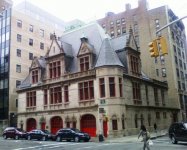
Additional costly restoration has taken place, bringing No. 87 Lafayette Street back to its former glory. The New York Landmarks Preservation Commission noted in 1966 "the quality of its detail and in the use of fine materials it is unsurpassed by any building in its category."
Absurdly extravagant or not, I prefer LeBrun's Loire Valley chateau to a suburban garage.
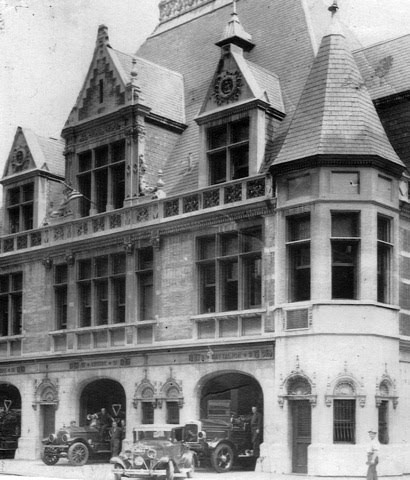
Engine Company 31 - 87 Lafayette Street
photo NYPL Collection In 1879 Napoleon LeBrun became the official architect of the New York City Fire Department. When son Pierre joi...


